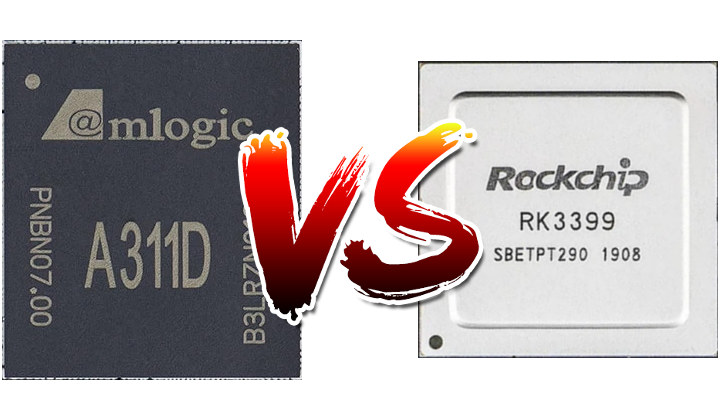I’ve run some benchmarks on Khadas VIM3 SBC earlier this morning. The board is powered by the latest Amlogic A311D hexa-core Cortex-A73/A53 processor, and I’ve found results to be impressive. But let’s see how it compares to another hexa-core processor, namely the popular Rockchip RK3399 Cortex-A72/A53 processor released in 2016 and found in several Chromebooks, TV boxes, and development boards.
To do so, I’ve compared Antutu 7.x, PCMark 10 Work 2.0, and 3Dmark benchmark results in Khadas VIM3 board running Android 9, against an actively-cooled Rockchip RK3399 SBC running Android 8.1. The results for A311D should be the same as for Amlogic S922X-B processor, so this post could also serve as an Amlogic S922X-B vs RK3399 comparison.
 Amlogic A311D vs Rockchip RK3399 – Key features
Amlogic A311D vs Rockchip RK3399 – Key features
| Amlogic A311D | Rockchip RK3399 | |
| CPU | Quad-core Cortex-A73 @ 2.21 GHz Dual-core Cortex-A53 @ 1.8 GHz |
Dual-core Cortex-A72 @ 1.8 GHz Quad-core Cortex A53 @ 1.416 GHz |
| GPU | Arm Mali-G52MP4 | ARM Mali-T860MP4 |
| NPU | Yes (5.0 TOPS) | No, but RK3399Pro model has a 3.0 TOPS NPU |
| Multimedia | ||
| – 4K 10-bit HEVC decode | Up to 60 fps | |
| – 4K VP9 decode | Up to 60 fps | |
| – 4K H.264 decode | Up to 30 fps (8-bit only) | Up to 30 fps (8-bit and 10-bit) |
| – Encode | 1080p60 H.264/H.265 | 1080p30 H.264, MVC, and VP8 |
| – HDR | Dolby Vision, HDR10, HDR10+, HLG, and PRIME HDR | No |
Contrary to Amlogic A311D/S922X-B, Rockchip RK3399 is not a TV box SoC, so the Amlogic processor will have better multi-media functions such as HDR (High-Dynamic Range) support, and overall better audio support & video playback compared to the Rockchip processor.
Amlogic A311D also comes with a 5.0 TOPS NPU (Neural-network Processing Unit), while RK3399 does not have one, but Rockchip does have an alternative with Rockchip RK3399Pro equipped with a 3.0 TOPS NPU. It’s a little early to test AI acceleration on A311D however, as the SDK will only be ready at the end of August.
Just based on the specifications (4x A73 + 2x A53 against 2x A72 + 4x A53), the Amlogic should be faster, but to find out just how much we’ve run some benchmarks.
Amlogic A311D vs Rockchip RK3399 – Benchmarks
| Amlogic A311D | Rockchip RK3399 | Ratio | |
| Antutu 7.x | |||
| Overall | 131,555 | 99,041 | 1.33x |
| CPU | 53,350 | 38,453 | 1.39x |
| GPU | 35,473 | 25,146 | 1.41x |
| UX | 33,731 | 30,217 | 1.12x |
| MEM | 6,001 | 5,225 | 1.15x |
| PCMark 10 | |||
| Overall | 5,968 | 4,805 | 1.24x |
| Web Browsing 2.0 | 6,450 | 4,839 | 1.33x |
| Video Editing | 5,298 | 4,640 | 1.14x |
| Writing 2.0 | 5,713 | 4,078 | 1.40x |
| Photo Editing 2.0 | 7,164 | 6,403 | 1.12x |
| Data Manipulation | 5,435 | 4,369 | 1.24x |
| 3DMark – Sling Shot Extreme | |||
| Total score | 1,187 | 819 | 1.45x |
| Graphics score | 1,050 | 761 | 1.38x |
| Physics score | 2,180 | 1,117 | 1.95x |
When it comes to performance, A311D is clearly ahead with around 40% improved CPU & GPU performance in Antutu, and 15% higher memory bandwidth. PCMark 10 score is 24% higher, with web browsing 33% percent faster, and Writing 2.0 getting a 40% boost. To remove potential confusion about the exact purpose of the latter test, Writing 2.0 measures the time to open, edit, and save a document using the native Android EditText view and the PdfDocument API. 3D graphics score is 45% higher in Sling Shot Extreme in 3DMark, which makes me want to try some games in Android before switching to Linux…
Khadas offers both RK3399 and A311D boards with a similar configuration, so we can compare pricing as well, and surprisingly non-promotional price for Khadas VIM3 Basic (2GB RAM/16GB storage, $99.99) is about the same as RK3399 based Khadas Edge Basic (2GB/16GB, $99.90)

Jean-Luc started CNX Software in 2010 as a part-time endeavor, before quitting his job as a software engineering manager, and starting to write daily news, and reviews full time later in 2011.
Support CNX Software! Donate via cryptocurrencies, become a Patron on Patreon, or purchase goods on Amazon or Aliexpress





